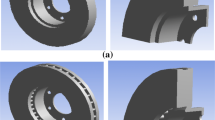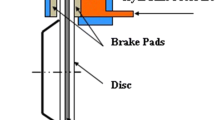Abstract
Ventilated disc brakes are widely used for reducing velocity due to their braking stability, controllability and ability to prove a wide-ranging brake torque. During braking, the kinetic energy and potential energies of a moving vehicle are converted into thermal energy through friction heating between the brake disc and the pads. The object of the present study is to investigate the temperature and thermal stress in the ventilated disc-pad brake during single brake. The brake disc is decelerated at the initial speed with constant acceleration, until the disc comes to a stop. The ventilated pad-disc brake assembly is built by a 3D model with a thermo-mechanical coupling boundary condition and multi-body model technique. To verify the simulation results, an experimental investigation is carried out.
Similar content being viewed by others
References
J. H. Choi and I. Lee, Transient thermoelastic analysis of disk brake in frictional contact, Journal of Thermal Stresses, 26, (2003) 223–244.
J. H. Choi and I. Lee, Finite element analysis of transient thermoelastic behaviors in disk brake, Wear, 257(1), (2004) 47–58.
C. H. Gao and X. Z. Lin, Transient temperature field analysis of a brake in a non-axisymmetric three-dimensional model, Journal of Materials Processing Technology, 129, (2002) 513–517.
C. H. Gao, J. M. Huang, X. Z. Lin and X. S. Tang, Stress analysis of thermal fatigue fracture of brake discs based on thermomechanical coupling, Journal of Tribology Transactions of the ASME, 129(3), (2007) 536–543.
P. Hwang, X. Wu, S. W. Cho and Y. B. Jeon, Temperature and coning analysis of ventilated brake disc based on finite element technique, (2007), SAE 2007-01-3670.
P. Hwang, X. Wu and Y. B. Jeon, Repeated brake temperature analysis of ventilated brake disc on the downhill road, (2008), SAE 2008-01-2571.
K. J. Lee, Numerical prediction of brake fluid temperature rise during braking and heat soaking, (1999), SAE 1999-01-1483.
R. Limpert, Brake Design and Safety, Second ed. Warrendale, PA: Science of Automotive Engineers Inc, USA, (1992).
A. E. Anderson and R. A., Knapp, Hot spotting in automotive friction systems, Wear, 135, (1990) 319–337.
Author information
Authors and Affiliations
Corresponding author
Additional information
Pyung Hwang received his B.S. in Mechanical Design & Production Engineering, M.S. and Ph.D. degrees from Seoul National University in 1979, 1981 and 1989, respectively. Dr. Hwang is currently a Professor at the School of Mechanical Engineering at Yeungnam University, Korea. His research interests include Tribology and Rotordynamics.
Rights and permissions
About this article
Cite this article
Hwang, P., Wu, X. Investigation of temperature and thermal stress in ventilated disc brake based on 3D thermo-mechanical coupling model. J Mech Sci Technol 24, 81–84 (2010). https://doi.org/10.1007/s12206-009-1116-7
Received:
Revised:
Accepted:
Published:
Issue Date:
DOI: https://doi.org/10.1007/s12206-009-1116-7




